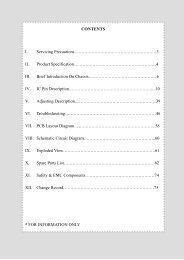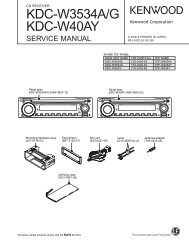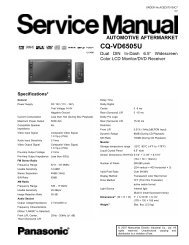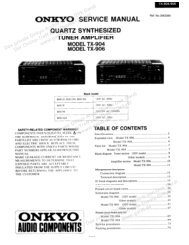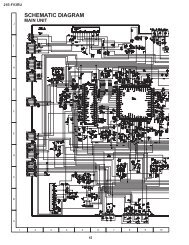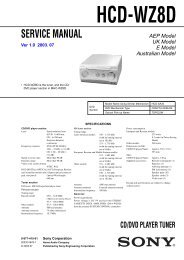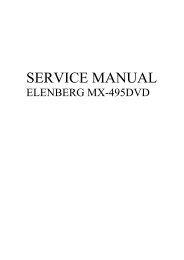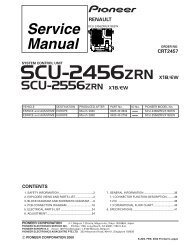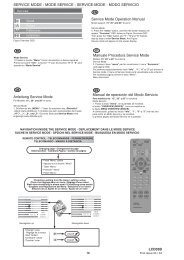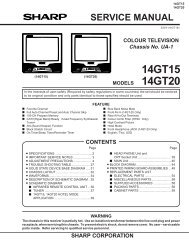Technology of Q 2500 colour TV set
Technology of Q 2500 colour TV set
Technology of Q 2500 colour TV set
You also want an ePaper? Increase the reach of your titles
YUMPU automatically turns print PDFs into web optimized ePapers that Google loves.
<strong>Technology</strong> <strong>of</strong> Q <strong>2500</strong> <strong>colour</strong> <strong>TV</strong> <strong>set</strong>The Circle Surround Decoder operates with anormal stereo signal. From this stereo signalthe decoder decodes the 6 sound channels.This function has the advantage that for thegreat majority <strong>of</strong> stereo transmitters a 5.1 surroundsignal can already be used.Dolby Pro Logic supports four sound channels.2 channels for front left and right1 centre channel1 mono surround channelDeepsoundchannelLFE7KHznoDolby Pro Logic also operates with a stereosignal, this must, however, also be coded withthe Dolby Pro Logic standard. If this is not thecase then no Center/Surround Signal is produced.NF bandwidth <strong>of</strong> the sound channelsDolbyProDolbyDigitalCircleSurroundLogic 5.12 channelsFront L/R20Hz-20KHz20Hz-20KHz20Hz-20KHz2 channelsSurroundno 20Hz-20KHz20Hz-20KHzMono 100- no noSurround 7kHzCenter 20Hz- 20Hz- 20Hz-20KHz20Hz-100Hz20KHz20Hz-100HzThe AC 3 modules can receive digital audiosignals via three paths.• I 2 S bus data supplied from MSP 341x onthe signal board.• SPDIF audio data from the two digital AudioCinch input sockets.• SPDIF audio data form the internal DVBi 2Decoder (deliverable end 2002, not usedin all device variants).The AC 3 module cannot process any analoguesound signals directly. The analoguesound signals from internal – e.g. Sat unit,tuner or DB module – as also from external –e.g. video recorder – sound signal sources,must first be converted into digital sound busdata (I 2 S bus). This task is implemented bythe Multi Sound Processor MSP 341x, whichis incorporated into the signal board.The digital I 2 S bus data is emitted by MSP I2051 on pins 4/5 and 6 and are fed to the AC3 module via pins 5/6/7 <strong>of</strong> contact connectorW 2071. All analogue sound output signals tothe AV sockets and the headphones amplifierare delivered by the MSP. The AC 3 modulehas no influence on these output signals. TheAC 3 module does not deliver any I 2 S busdata back to the MSP. This also means thatno sound signals are delivered to the AVsockets and the headphones amplifier, if signalsare supplied only via the SPDIF Cinchsockets.The SPDIF signals (SPDIF Sony Philips DigitalInterFace, level 0.7 Vss-1 Vss to 75 Ohm)are supplied by the Cinch sockets to the contactstrip W 2091 pin 14 SPDIF in1 and pin 11SPDIF in2.SPDIF data from DVBi 2 module is supplied toW 2091 pin 10.The SPDIF signals reach the AC 3 module onchangeover switch I 18. This is controlled bythe I 2 C bus expander I 11 via pin 2/4. TheSPDIF signal selected for processing is outputto pin 7 <strong>of</strong> I 18. The selected signal is alsoreturned to the SPDIF Cinch outputs via pin12 <strong>of</strong> Q 11 and W 301.I 2 converts the SPDIF signal – input pin 42 –<strong>of</strong> the I 2 S bus data – I 2 pins 1/43/44 - fromMSP in the I 2 S bus data for the I 1 (DSP -Digital Sound Processor). I 1 processes thisaudio data according to the prescribed standard.For this the respective s<strong>of</strong>tware requiredis loaded from I 5 memory. The memory isorganised into 8 blocks, each <strong>of</strong> 32 kByte. ForCircle Surround, Doby Pro Logic and DolbyDigital a 32 kByte block respectively is required.If, for example, Circle Surround isswitched to Dolby Surround, the CCU controlsExpander I 11 via the I 2 C bus in such a waythat the address switching lines I 11 pin9/10/11 <strong>of</strong> the memory block in I 5 for DolbySurround can be selected. DSP I 1 receivesan interrupt from CCU pin 77 via pin 14 <strong>of</strong> W321.Document Q <strong>2500</strong> 122 © Loewe ProCollege



